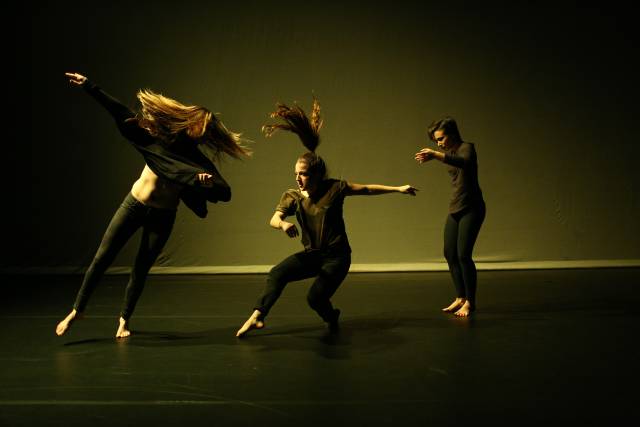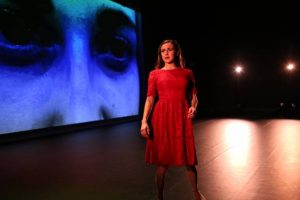

Hollye Bynum, choreographer and Artistic Director of her company, of bones || hollye bynum, presented a full-length, stage and screen production, RELEASE, at the 14th Street Y on December 17, 2015 as a part of the theater's inaugural 2015-2016 Dance Series. RELEASE is the first production from of bones || hollye bynum to include both filmed and staged dance.
The evening is broken up into small segments that interconnect and rely thematically upon one another. Bynum uses film to provide another perspective—a voyeuristic one. Her use of the camera allows us to gradually enter the given environment; we become more and more intimately involved with the characters, all vulnerable and disquieted women who seek and ultimately find release. The work is left open-ended, and the audience is kept wondering what will happen to these characters who, powerfully restrained, break free and become loose cannons.

The opening number sets the stage, and screen, for an evening of noisy bursts of emotional discomfort. Intro opens with video of women going about their business, whether walking down the street, looking into a mirror, or sitting with others at a cafe. What happens here in the beginning, and what we continue to see throughout the stage and screen production, is disquiet bubbling forth to the surface until its release. The dancers who we just saw on screen begin to appear on the stage and take on expansive and sequential movement that is explosive and liberating.
Mid-way through the production is a section that explores and uncovers the skin-crawling feeling of ruefulness. The section includes a two-part solo work titled Wash Me and a group number, Pretty Little Things, which begins, once again, on screen. As voyeurs, we watch a young woman (Ashley Menestrina) sitting in her bathtub, tense and troubled, awaiting her own boiling point. Bynum’s portrayal of the body on film is made up close-ups and speed alterations (another recurring quality), which enables the viewer to get closer to the subject and focus on her internal struggle that is individual here, yet universal. Pretty Little Things begins with Maite Arregui, Skurakao Awana and Caitlin Sheppard joining Menestrina on the stage; our original character is not alone in her distress. The section ends as the three slither around Menestrina's legs—we wonder if our subject will become free or will be washed away with her regret.
Another example of Bynum’s introspective and disquieted characters is seen strongly in We’re Fucked Up, Aren’t We. At the beginning of this piece, Sam Owens is dressed in a sheer nightgown and is sitting in a chair downstage. A video projection of family memories has faded and dancer Caitlin Sheppard, dressed similarly in a nightgown, sneaks up behind Owens in what would normally be a playful action: covering her eyes from behind. Here, the childish “guess who” encounter is rather menacing. The duet reveals a conflicted sister relationship that is at once intimate and volatile. Silhouettes provide a backdrop, with shadows of the dancers as well as of the chair, which becomes a character of its own—an outlier and victim of the relationship. In this piece, we see Bynum’s eloquence at its best, executed beautifully through refined phrasing and delicately intricate parenting work.